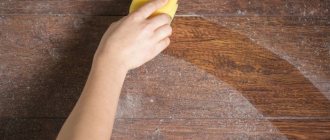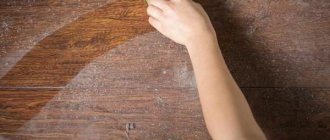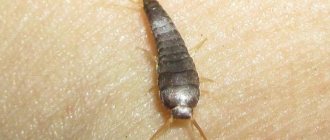What is dust? Perhaps not each of us knows what is included in its composition and how its elements affect our health. You will learn about what dust consists of, why it is dangerous and how to deal with it in our article.
The apartment is the “best” dust collector in the world. Every year, up to 20 kg of dust settles in an ordinary small two-room Khrushchev house. Even a closed, uninhabited room becomes covered with a layer of dust in a short period of time. Where does this “pollutant” come from in our homes? It turns out that the largest percentage (about 70%) of dust reaches us from afar, and only 30 percent is produced due to human activity.
As scientists have found, the Sahara Desert is the most important source of dust for the entire Earth. From its territories, the wind annually raises an average of 150 million tons of dust.
The second no less important and large “dust source” is the Sakurajima volcano, located on Japanese lands. At this time, it is active, so periodically up to 14 million tons of volcanic ash are released into the atmosphere from its vent. And the city, located several kilometers from the volcano, is constantly covered with a layer of dust.
In addition to the largest worldly dust sources on land, there are also seas and oceans. Due to the high percentage of salt content, the world's oceans also deliver a percentage of dust into the air during evaporation, forming clouds. The Earth's atmosphere has not gone unnoticed by space. Thanks to space objects, the mass of the Earth increases by 9 tons due to settled comet and meteorite dust. All these examples of the inanimate world take place in our apartment. Surprisingly, even waste from penguins living in Antarctica can reach our homes. Thus, a wide variety of particles gather together, mix with air and turn into dust.
Dust will stop at nothing, even thousands of kilometers do not frighten it. In order to get into your home, she will go through the most difficult paths and reach her goal.
Dust appears in apartments because some vital processes are constantly taking place in them: small particles flake off from the upper layer of human skin (epidermis), pets leave their fur, food dries out, wakes up, crumbles and also leaves small grains. In addition, dust also comes from outside - its small particles can travel many kilometers before they get into your apartment.
What is dust and where does it come from?
Dust is called small particles with a small mass, the lightest of them are in the air, their state can be called “suspended”, and the heaviest settle on surrounding objects.
It is a mistake to think that dust particles are the result of human intervention in nature and human activities. Most of it is formed in nature and is constantly “hovering” in the air.
Dust is emitted from volcanoes and the wind carries it thousands of kilometers. Another source can be called the very surface of the Earth and grains of sand from the African desert may end up on another continent. The World Ocean can also be called a “producer” of dust particles, when dried foam is converted into small mineral residues and, thanks to coastal winds, quickly moves in the air. In addition, atmospheric layers are also sources of dust that settles on the Earth’s surface.
The composition of dust in the air in a residential area is as follows:
- 30–35% mineral particles;
- 20–25% of components of unknown origin;
- 18–20% skin particles;
- 10–15% textile and paper fibers;
- 5–10% pollen;
- 3–5% soot and smoke.
A gray coating of small particles is present even in non-residential premises with tightly closed windows and doors, since dust is constantly in the air. Even when there is no furniture in the room, its particles cover the walls, ceiling, radiators, and glass on the windows.
But many of us may have noticed that one room needs cleaning 1-2 times a week, while in another room plaque accumulates daily. There are a number of factors that influence the amount of dust particles settling in a room.
The benefits and harms of dust particles
With large particles, dust settles quickly and is easy to deal with; you can simply remove it with a damp cloth. Fine particles pose a risk to human health. They settle on objects slowly and enter the human body through the respiratory tract. Dust particles of mineral origin are especially dangerous; a common source is house insulation material. A person's immunity decreases and malignant tumors can form. When it gets into food and drinking water, pulmonary diseases and infectious diseases develop.
Dust has negative qualities and a person receives dangerous consequences from interacting with it. But it has a positive effect on the planet:
- Dust particles take an active part in the formation of clouds and fall as precipitation on the ground. Without it, the land could turn into a desert and life on earth would cease.
- Dust in the atmosphere affects the climate.
- Dust grains absorb some of the solar radiation and mitigate global warming.
Where does dust come from in an apartment or house?
In the apartments of residents of large cities, more dust settles than in a village house. Megacities are sources of huge amounts of fine particles due to more people, cars, manufacturing plants and construction sites.
- In addition, residents of apartments located on the lower floors have to clean much more often than those who live “under the roof.”
- The amount of “gray plaque” in a home is also influenced by roads; the closer the house is to the highway and the more active the car traffic, the more dust will settle on sofas, cabinets and the floor.
- The proximity of manufacturing enterprises and construction sites will also add more worries to the housewife when maintaining cleanliness in the apartment. Small particles of sand, cement and various “loose” substances will constantly penetrate into your home, and force you to pick up a rag and vacuum cleaner more often.
Ideal “dust collectors” in our apartments
The amount of dust in an apartment also depends on its interior. There are a number of things that attract small gray particles, which will not be so easy to remove. These include:
- Carpeting. A huge amount of dust “sticks” to the small fibers on your rug every day, and to maintain relative cleanliness in the room you will have to vacuum the floor daily and periodically wet clean the carpet.
- Unnecessary trash. How much dust boxes and suitcases can collect, lying idle for years in closets and on mezzanines! And also things that are rarely used by the owners, but are in plain sight. The fight should begin precisely with these “deposits”, throwing away everything unnecessary, and what you use from time to time is better to put in boxes and remove from there as needed.
- Collectibles. Another ideal “dust collector” is an object standing on a shelf: a figurine, a model of a car or sailboat, a plush toy. To save yourself the hassle of regularly cleaning parts of your collection, it’s best to store them behind glass.
- Thick curtains and canopies. These interior items literally attract dust particles and small debris; it is much better to replace them with light tulle or blinds.
- Heating batteries. Dust enters the home through windows, and radiators are usually located under them, and many particles settle here.
All of these items contribute to the accumulation of a lot of dust in the room, which is difficult to get rid of.
Do wet cleaning more often
The advice is as old as the world and has still not lost its relevance. Damp cleaning is not only aesthetic, but also medical. Controlling Dust, Dust Mites, and Other Allergens in Your Home / Michigan Medicine: University of Michigan, especially if you suffer from allergies and asthma. We arm ourselves with a rag. It is better if it is made of microfiber. You can easily collect all the dust with a dry one, and then seal the result with a wet one.
It’s also convenient to use a fluffy broom with the funny name “pipidastr” to combat dust. Its synthetic fibers do not brush away, but attract particles, which significantly speeds up cleaning even in hard-to-reach places.
Why is dust dangerous?
Gray plaque on furniture, walls and floors not only gives the home an untidy appearance, but can also harm the health of the people who live here. Microparticles enter the respiratory tract, which leads to allergies and diseases of the lungs and bronchi.
Some types of particles during the decomposition process are capable of releasing toxic substances, which can also lead to various complications and deterioration of health. In addition, dust is a favorite habitat for dust mites.
They enter our home from the street, we “bring” them into the house on our clothes and shoes. As a result of the vital activity of these creatures and various secretions, the atmosphere in the home sharply deteriorates, which threatens the development of asthma, bronchitis and pneumonia in the people living there.
You will be helped by general cleaning of your home in compliance with all rules for getting rid of dust.
Installation of the built-in filter
To avoid searching for such water, you can simply install special water purifying filters at home. Moreover, you need to do this not for the sake of the humidifier, but for your own health. Drinking this water will help you avoid many diseases. As for the humidifier, using filtered water will result in no white residue.
Filters are:
- coal;
- with an ion exchange resin structure;
- based on fiberglass.
And most importantly, the difference lies not in quality, but in price. To solve the problem described, any option is suitable.
How to get rid of dust in an apartment
A systematic approach is important in combating it. When you're cleaning out your home, consider the following tips to reduce the amount of dust in your home:
- Leave fewer things “in sight”, put them in a tightly closed cabinet, behind a glass display case, and throw away the unnecessary ones.
- Upholstered furniture should be cleaned with a vacuum cleaner, and this should be done regularly. It will help to get rid of dust in furniture covers by “knocking out” through a damp cloth.
- Treat curtains with a steamer. If you have thick curtains on your windows, you can solve the problem by ironing them.
- Clean carpets, pillows and soft toys regularly.
- Install screens on the windows, this will help reduce the amount of dust inside the apartment.
- Don't forget to ventilate all rooms.
- Windows need to be washed at least once a month.
- If you have pets, wash their paws thoroughly after walking.
- Carry out wet cleaning at least 2 times a week.
- Vacuum and wash radiators; dirt accumulates quickly in these places.
- Get indoor plants, this will give the air in your apartment additional freshness.
It is not possible to completely get rid of dust, but it is possible to reduce the intensity of its occurrence in your home.
If you add a little potassium permanganate to the water in which you wet the cloth for wiping dust, then dust will accumulate on the surfaces more slowly.
Should I be afraid?
White residue from an air humidifier is fraught with many unpleasant moments, but only two are the most important:
- The need to constantly clean the room. In this case, cleaning is not only wiping off dust, because white plaque settles in a continuous layer on absolutely all surfaces, including any fabric surfaces, which are much more difficult to clean.
- Risk of harm to health. Since the deposition of white plaque occurs on absolutely all surfaces, it is absolutely natural that this plaque gets into the human lungs with the air. And this carries the risk of developing a number of different diseases, including allergic ones.
We recommend: Architectural elements of the building facade in pictures: photos and videos
It is worth saying that numerous studies conducted by foreign scientists have not been able to prove that the use of ultrasonic humidifiers can in any way cause harm to human health. However, safety is ensured only by full compliance with all necessary rules for operating humidifying devices. If you do not follow them - use ordinary water instead of distilled - the health consequences can be negative.
How to clean the air from dust
To clear the air of dust in an apartment or house you need to:
- carry out general cleaning;
- wash curtains and fabric covers;
- wet wipe the floor and all open surfaces;
- ventilate the rooms;
- humidify the air.
How to remove dust from wallpaper and ceiling
Many particles collect on the wallpaper and ceiling, and when cleaning, you should not forget about them. To clean the ceiling and walls, use a special brush with artificial bristles that can become electrified.
Thanks to static electricity, small particles will be “attracted” to the bristles of the brush, which will help clean your ceiling and wallpaper of its particles.
Instead of a brush, you can use a vacuum cleaner; it will do the job just as well. If the covering of the walls and ceiling allows for wet cleaning, do not neglect it. Before you start cleaning the walls this way, try cleaning a small area. If the surface has not been damaged as a result of getting wet and has retained its original appearance, feel free to proceed with further cleaning.
Clean the space regularly, don’t forget about “hard-to-reach” places, such as radiators, don’t be lazy about moving furniture away, and don’t turn your home into a warehouse for unnecessary things.
Household chemicals
When cleaning, you need to use household chemicals that reduce the ability of objects to accumulate static electricity. Microparticles, as a rule, have a certain microscopic charge of their own and are attracted to a surface that is oppositely charged. Antistatic treatment prevents particles from settling on the treated surface.
You can use any glass cleaner that does not contain alcohol. It perfectly cleans all surfaces from plastic panels, computers, wooden furniture to tiled walls. However, special products are even better suited for wooden surfaces.
Special disposable napkins have proven themselves well in everyday life. They are produced both universal and special: for plastic, wood, screens and glass, etc. Those sold in car dealerships and intended for car care are especially good.











